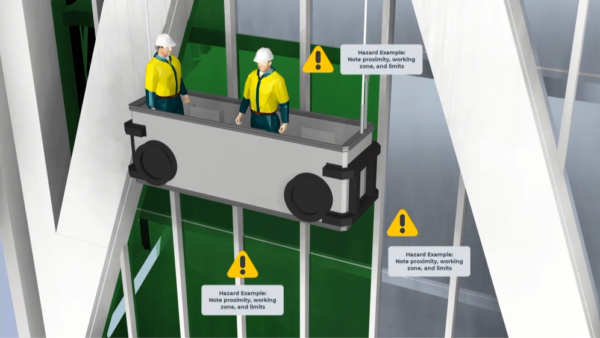
In the second and final part of a series about project handover, Lucas Cusack of Glider Technology turns his attention to the contractor’s role. Here, he looks at the role contractors play in delivering accurate, structured information that’s ready for effective use in building operations.
A successful handover is the result of careful planning, consistent communication and proactive management throughout the design and construction process. So, what more can main contractors do to ensure a successful handover?
Start early – handover starts in design
Based on the asset information requirements (AIR), contractors should understand what needs to be delivered as specified by the client. Most of this data will come from the supply chain, so it’s important to include these requirements in tenders and contracts so that it doesn’t come as a surprise later.

“Trade contractors typically have handover information they can provide immediately. These deliverables should be confirmed and tracked early.”
From the beginning of a package delivery, trade contractors typically have handover information they can provide immediately. These deliverables should be confirmed and tracked early. Gathering data as it becomes available avoids a last-minute scramble at the end of the project.
Sadly, in today’s market, some trade contractors may go into administration during the project. If the handover of their information is left until the end, it may never be recovered.
Ensure information is collected and stored consistently
Contractors are responsible for ensuring all building information is collected, organised and stored correctly throughout the construction process. The information gathered at each stage must be accurate, relevant and align with the client’s AIR and exchange information requirements (EIR). To make this easier, contractors should use a robust information management system that allows them to capture and track asset information systematically, to prevent gaps or inconsistencies during the project.
A project information management common data environment (PIM CDE) can ensure that all data is centrally stored, accessible and reduces the risk of valuable information being lost, misplaced or not properly updated. It also helps ensure that the handover information is consistent with the client’s requirements and is available for review at any stage of the project.
Collaborate with the client and other stakeholders
Collaboration is key to a successful handover. Contractors must work closely with the client, project managers and any other relevant stakeholders, such as facilities managers and technology providers, throughout the construction process. This ensures that the contractor is fully aware of the client’s expectations and any changes in operational needs that may arise during the project.
For example, we’ve seen how emerging new technologies or updates to the building’s design can affect the information the client needs for the effective operation of the building. A contractor that maintains open lines of communication with the client can make adjustments so that the final handover information meets the client’s operational and long-term needs. Early engagement with the client’s FM team is particularly important for addressing any information requirements for the ongoing management of the building once it is operational.
Ensure the accuracy and completeness of the handover information
“Conducting regular quality checks and audits throughout the construction process can help to ensure the completeness and accuracy of the handover information.”
Contractors must ensure the data handed over is both complete and correct. This involves verifying that all required information is included, that it meets the specified standards, and that it is presented in a way that can be easily used by the client and their operational teams.
The information should be structured and organised in accordance with the AIR and EIR, and presented in a format that is easily accessible and usable.
Conducting regular quality checks and audits throughout the construction process can help to ensure the completeness and accuracy of the handover information. This helps identify potential issues early, ensuring that the final handover is as smooth and seamless as possible.
Align BIM to smart requirements
Too often, BIM requirements and processes are handled separately to smart requirements and processes. There will be AIR and EIR, but also a smart building strategy. The AIR will stipulate asset naming for physical assets, but not virtual assets and data points, so often when the building services contractors install equipment like the building management system, they don’t receive any instruction on data point naming that relates to the AIR. This results in thousands of data points providing information every few seconds that has little to no correlation back to the handover information.
Implement a digital soft landing
Just like the client, contractors also play a key role in ensuring a successful digital soft landing. The transition from construction to operation can be a complex process, involving the integration of a vast amount of data into the building’s operational systems. Contractors should ensure that the information handed over is fully compatible with the client’s systems and is formatted in a way that facilitates easy integration.
This includes aligning the handover information with the client’s operational and maintenance needs. Contractors should work closely with the client’s FM team to ensure that all necessary maintenance schedules, asset data and compliance information are included in the handover and are easily accessible for ongoing use.
A digital soft landings manager can help to bridge the gap between BIM and smart, following the data trail from design to construction to operation. This process will naturally align BIM deliverables to the asset data naming standards that the operational technology will be commissioned to produce.
Common pitfalls to avoid
- Delaying handover information collection: Waiting until the end of the project makes gathering information, especially from offsite subcontractors, significantly harder and riskier.
- Inconsistent data management: Failing to use a robust system for collecting, organising and storing information leads to gaps, inaccuracies and difficulties in handover.
- Poor communication and collaboration: Failing to engage early and often with the client and stakeholders can lead to misalignment and rework.
- Lack of quality checks: Not verifying the accuracy and completeness of handover information can lead to errors and delays in the final handover.
- Disconnect between BIM and smart: Treating BIM and smart requirements in isolation results in handover data that is not effectively integrated with the building’s operational systems.
- Ignoring client data format preferences: Not understanding and aligning with the client’s preferred data formats early on can cause delays and discrepancies during handover.
- Insufficient focus on digital soft landing: Neglecting the integration and usability of digital handover information can slow the client’s transition to building operations.
Handover isn’t just a milestone, it’s the bridge between construction and long-term building operations. Too often, it’s an afterthought, leading to unnecessary costs and operational headaches down the line. But when contractors treat handover as a critical deliverable, just like the physical building itself, the benefits are clear. Clients can hit the ground running, facilities teams have the information they need from day one, and the building operates as intended.
Don’t miss out on BIM, information management and digital construction news: sign up to receive the BIMplus newsletter.












